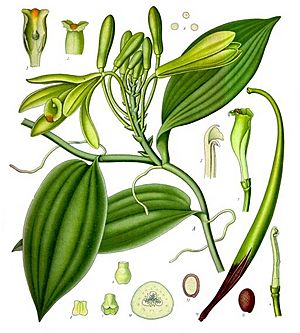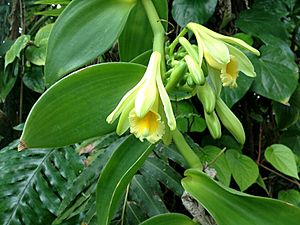Flat-leaved vanilla facts for kids
Quick facts for kids Flat-leaved vanilla |
|
|---|---|
 |
|
| Illustration of the vanilla plant from 1887 | |
| Conservation status | |
| Scientific classification | |
| Genus: |
Vanilla
|
| Species: |
planifolia
|
| Synonyms | |
|
|
Vanilla planifolia is a type of vanilla orchid that naturally grows in places like Mexico, Central America, Colombia, and Brazil. It's super important because it's one of the main plants we get vanilla flavouring from. This is thanks to a special chemical inside called vanillin.
People often call it "flat-leaved vanilla" or "West Indian vanilla." Sometimes, it's just called "the vanilla." Scientists first gave it its official name in 1808. Sadly, the number of Vanilla planifolia plants is going down, and their natural homes are being used for other things. Because of this, the IUCN (a group that checks on plants and animals) says Vanilla planifolia is an endangered species.
Contents
What it Looks Like
Vanilla planifolia is an evergreen vine. This means it stays green all year round. It can grow on the ground or climb up trees. Sometimes, it even grows as an epiphyte, which means it lives on other plants without rooting in the soil.
In the wild, this vine can easily grow up to 15 meters (about 50 feet) long, and sometimes even reach 30 meters (almost 100 feet)! When it grows in shady spots, it doesn't branch out much. But if it gets lots of sunlight, it will grow many branches.
The younger parts of the vine have a zig-zag shape and stick well to whatever they're climbing on. To hold onto trees, it has thick, fleshy roots that grow out from its stem. These roots help it cling tightly. The older parts of the vine often hang down towards the forest floor.
Each stem has a single, flat, shiny green leaf. These leaves are usually 8–25 cm (3–10 inches) long and 2–8 cm (1–3 inches) wide. They are shaped like a spearhead or an oval with a pointed tip. A leaf can last for three to four years if it doesn't get damaged.
Flowers and Reproduction
The flowers grow in clusters, with 12 to 20 buds in each group. They are greenish-yellow and about 5 cm (2 inches) wide. They don't have a strong smell. For the plant to make fruit, its flowers need to be pollinated.
Vanilla flowers open in the morning and usually close by the afternoon as temperatures rise. Even though each flower only lasts one day, the plant blooms for about two months each year. In its natural home, flowering happens in April and May, at the end of the dry season.
The plants can self-pollinate, meaning pollen can move from one part of the same flower to another. However, the flower's structure makes this hard without help. In the wild, only about 1% of the flowers get pollinated naturally.
Fruit (Vanilla Pods)
The plant only makes fruit when it's mature, usually when it's over 3 meters (10 feet) long. The fruits are long pods, about 15–23 cm (6–9 inches) in length. People often incorrectly call them "beans." They look a bit like small bananas. It takes about eight to nine months for these pods to fully grow.
Where it Grows
Vanilla planifolia originally comes from a warm, wet area called the neotropical realm. This includes southern Mexico, Central America, Colombia, and northern Brazil.
Because people grow it for vanilla, it has also spread to many other tropical places. You can now find it in parts of Florida, the Caribbean islands, Peru, Ecuador, and even far-off places like Madagascar, Indonesia, and New Guinea.
This plant loves a warm, humid tropical climate. It grows best when the temperature is between 20 and 30 degrees Celsius (68-86°F). It needs at least 2000 mm (about 79 inches) of rain each year. For it to grow well, the soil also needs to have enough calcium and potassium. It prefers soil that drains well and has a pH between 6.0 and 7.0. It naturally grows at altitudes from 150 to 900 meters (about 500 to 3000 feet). To make flowers, it needs a dry period in the spring.
Sadly, because people are using land for farming and cutting down trees, the natural homes for Vanilla planifolia are shrinking. The number of wild plants is going down, and there's less suitable land for them. This is why the IUCN officially listed it as endangered in 2020.
How it Interacts with Nature
In its natural home, Vanilla planifolia relies on certain animals to help with pollination. Scientists think different types of bees, like Euglossa and Eulaema species, might be the main pollinators. However, it's been hard to actually see them pollinating the flowers.
The seeds of Vanilla planifolia are very tiny, but they are bigger than most orchid seeds. They don't spread by wind. Instead, they are carried around the rainforest by different animals. Male orchid bees collect fragrances from the vanilla fruits, and in doing so, they help spread the seeds. Female stingless bees also remove the pulp of the fruit, which helps spread the seeds for their nests.
Animals like Tome's spiny rat and the common opossum are known to eat the fallen vanilla pods on the forest floor. Studies have shown that the seeds can still grow after passing through these animals' digestive systems.
What's Inside (Chemistry)
The main chemicals that give vanilla its flavor are found in the pods. The most important one is vanillin, which makes up about 80% of all the good-smelling compounds in Vanilla planifolia pods. Other chemicals, even in smaller amounts, also help create the rich vanilla flavor we love.
Skin Irritation
The sticky liquid (sap) that comes out of vanilla orchid stems or from where the pods are picked can cause a skin rash called contact dermatitis. This happens if the sap touches bare skin. The sap contains tiny crystals called calcium oxalate, which are thought to be the main reason for the rash. Luckily, the sap can be washed off with water.
How it's Grown (Cultivation)
Most Vanilla planifolia plants grown on farms are not grown from seeds. Instead, they are grown from cuttings, which means taking a piece of an existing plant and growing a new one from it. This helps keep the plants the same.
Because natural pollination is so rare, farmers have to hand-pollinate the flowers when they grow vanilla. This means they carefully move the pollen themselves.
Once the pods in a cluster start to turn yellow, they are usually picked. Then, they go through a special process called curing. Curing helps the pods ferment and develop their famous vanilla flavor. It also dries them while keeping their important oils inside. This is how we get vanilla extract.
Today, Vanilla planifolia is mostly grown and harvested in places like Veracruz, Mexico, Tahiti, Indonesia, and Madagascar.
See also
 In Spanish: Vanilla planifolia para niños
In Spanish: Vanilla planifolia para niños
- Vanilla tahitensis



